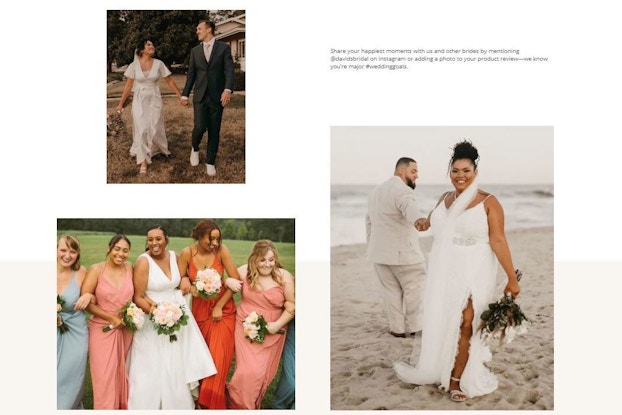
Why it matters:
- Brands have found that featuring content created by real people in real scenarios in marketing campaigns — rather than paid models and influencers — is striking an increasingly resonant chord with today’s consumers.
- User-generated content (UGC), like customer reviews and Instagram posts of shoppers touting their purchases, can drive higher sales conversion rates than traditional marketing methods.
- UGC can also provide consumers considering a purchase the ‘social proof’ they need to hit the ‘buy’ button.
Consumer brands have discovered that the best way to sell a dress, a sofa or a toy can be a photo of a happy customer wearing the dress, sitting on the sofa or playing with the toy.
Using content created by real people in marketing campaigns can mean real returns in increased sales and brand awareness.
Instagram, Facebook, Twitter or TikTok posts from customers showing off their purchases, dubbed user generated content (UGC) in industry parlance, can be such marketing gold that many brands are actively encouraging these posts with loyalty reward points, contests and other incentives.
Flower deliveries from 1-800-Flowers now arrive with a card offering a chance to win $500 by posting a photo of the floral arrangement on social media.
Toy brand Hasbro in March received hundreds of TikTok videos from fans professing their love of its Nerf blasters when it offered them a chance to apply for the role of Chief TikTok officer, a temporary job that will pay $10,000 a month.
Other brands have found their customers are eager to post photos and reviews without incentives.
Wedding retailer David’s Bridal and online furniture company Article have received a wealth of content from customers who simply want to share the news that they have found the dream wedding dress or perfect dining room table.
[Read here for a primer on user-generated content.]
Providing stories from customers, whether they are visual, [such as] Article in Real Life, or text-based, [like] customer reviews, helps give people a better idea of what to expect from our products in the real world.Duncan Blair, vice president of marketing, Article
Content from ‘real people in real scenarios,’ not actors and influencers, delivers authentic ‘social proof’
Content from real people, not paid models or representatives, resonates best with the real people you want to buy your products, brands and marketing experts told CO—.
“These aren’t custom production shoots with actors. These are real people in real scenarios,” Craig Caruso, senior director of Veritone, a tech firm with a content search and media licensing division, told CO—. “Aligning [a brand] with current trends, or real people, is a better and more effective way for companies to have their brand be remembered or their message resonate,” he said.
Content from actual customers, rather than paid influencers, gives brands what marketing company Yotpo calls “social proof.” Yotpo helps brands manage reviews, loyalty programs and customer outreach.
“Seeing that someone else like you trusts your brand and put money into your product, that’s social proof,” Ethan Cohen, director of customer success at Yotpo, told CO—. “That connection is very powerful.”
[Read here on tools to manage user-generated content.]
User-generated content can drive higher sales conversion rates
Brands that link their e-commerce websites to customer reviews and posts see higher conversion rates – the number of shoppers who make purchases, Cohen said.
Wedding retailer David’s Bridal has found that to be true. Its social media ad campaigns featuring user-generated content typically drive 40% more conversions at 4% lower cost, Ashley Fossile, digital marketing director at David’s Bridal, told CO—.
One of the wedding retailer’s user content successes, #FoundtheOne, was born after executives noticed that brides were posting photos of themselves at David’s Bridal stores after finding a dress.
The company in early 2019 gave each store heart-shaped “I Found the One” signs brides could hold for their posts. The future brides responded enthusiastically, tagging David’s Bridal in their posts. David’s Bridal then would ask permission to share the posts on its feeds.
Many of those shoppers went on to also tag David’s Bridal in their wedding days posts, with the retailer sharing those posts as well.
“Our customers want to be able to see women like them in our dresses,” Fossile said. “They don’t just want to see tall, thin models in dresses.” They want to see how it looks on everyday women, as opposed to models, he said.
When the pandemic caused David’s Bridal to temporarily close its stores, the brand created the #LoveFindsAWay campaign. “We used it to tell the story of brides who were moving forward with their weddings regardless of everything that was going on,” with posts about backyard weddings and Zoom ceremonies, Fossile said.

As part of that campaign, David’s Bridal in June began airing its first digital commercials featuring real people’s wedding videos.
“We could not have photo shoots at the beginning of the pandemic, so we were trying to figure out how [we could] still advertise,” Steve Holland, video and digital content director at David’s Bridal, told CO—.
“Using the real wedding videos was just a game changer,” he said. “If you’re watching TV and an ad has real weddings, you’re just automatically drawn to it more because you can tell that it’s real. You can tell by the way that everybody’s looking at each other that they’re not paid actors or models.”
The commercials drew over nine million views between June and October 2020.
Customer reviews and photos to move consumers from inspiration to purchase
Article, the eight-year-old digitally native furniture brand, began leveraging user-generated content after noticing its customers were sharing purchases on social media. In 2016, it started adding the #OurArticle tag, which has now been used on Instagram more than 20,000 times.
“It really evolved organically, with our customers eager to share and show off their beautiful new spaces with friends and family. We just gave it a name,” Duncan Blair, vice president of marketing at Article, told CO—.
Article posts reviews from customers on its website as well as a gallery of social media posts, called Article in Real Life.
“Providing stories from customers, whether they are visual, [such as] Article in Real Life, or text-based, [like] customer reviews, helps give people a better idea of what to expect from our products in the real world,” Blair said.
When customers are buying a $2,000 couch from a website sight unseen, seeing pictures of how other customers are using the products and decorating their homes “helps all the way along the journey, from sparking inspiration through to being confident enough to click ‘buy now,’” he said.
CO— aims to bring you inspiration from leading respected experts. However, before making any business decision, you should consult a professional who can advise you based on your individual situation.
Follow us on Instagram for more expert tips & business owners stories.
CO—is committed to helping you start, run and grow your small business. Learn more about the benefits of small business membership in the U.S. Chamber of Commerce, here.

Interested in a small business membership?
Find out how the U.S. Chamber of Commerce can help your company grow and thrive in today's rapidly-evolving business environment. Connect with our team to learn how a small business membership can benefit your bottom line and help you achieve your goals.







